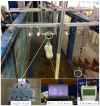Research on Flow Field Perception Based on Artificial Lateral Line Sensor System
- PMID: 29534499
- PMCID: PMC5877381
- DOI: 10.3390/s18030838
Research on Flow Field Perception Based on Artificial Lateral Line Sensor System
Abstract
In nature, the lateral line of fish is a peculiar and important organ for sensing the surrounding hydrodynamic environment, preying, escaping from predators and schooling. In this paper, by imitating the mechanism of fish lateral canal neuromasts, we developed an artificial lateral line system composed of micro-pressure sensors. Through hydrodynamic simulations, an optimized sensor structure was obtained and the pressure distribution models of the lateral surface were established in uniform flow and turbulent flow. Carrying out the corresponding underwater experiment, the validity of the numerical simulation method is verified by the comparison between the experimental data and the simulation results. In addition, a variety of effective research methods are proposed and validated for the flow velocity estimation and attitude perception in turbulent flow, respectively and the shape recognition of obstacles is realized by the neural network algorithm.
Keywords: artificial lateral line system; flow field perception; hydrodynamic simulation; neural network; velocity estimation.
Conflict of interest statement
The authors declare no conflicts of interest.
Figures






























Similar articles
-
Flow Field Perception of a Moving Carrier Based on an Artificial Lateral Line System.Sensors (Basel). 2020 Mar 9;20(5):1512. doi: 10.3390/s20051512. Sensors (Basel). 2020. PMID: 32182939 Free PMC article.
-
Flow field perception based on the fish lateral line system.Bioinspir Biomim. 2019 May 3;14(4):041001. doi: 10.1088/1748-3190/ab1a8d. Bioinspir Biomim. 2019. PMID: 30995633 Review.
-
Distributed flow estimation and closed-loop control of an underwater vehicle with a multi-modal artificial lateral line.Bioinspir Biomim. 2015 Mar 25;10(2):025002. doi: 10.1088/1748-3190/10/2/025002. Bioinspir Biomim. 2015. PMID: 25807584
-
Artificial fish skin of self-powered micro-electromechanical systems hair cells for sensing hydrodynamic flow phenomena.J R Soc Interface. 2015 Oct 6;12(111):20150322. doi: 10.1098/rsif.2015.0322. J R Soc Interface. 2015. PMID: 26423435 Free PMC article.
-
A Review of Artificial Lateral Line in Sensor Fabrication and Bionic Applications for Robot Fish.Appl Bionics Biomech. 2016;2016:4732703. doi: 10.1155/2016/4732703. Epub 2016 Dec 27. Appl Bionics Biomech. 2016. PMID: 28115825 Free PMC article. Review.
Cited by
-
Flow Field Perception of a Moving Carrier Based on an Artificial Lateral Line System.Sensors (Basel). 2020 Mar 9;20(5):1512. doi: 10.3390/s20051512. Sensors (Basel). 2020. PMID: 32182939 Free PMC article.
-
Optimal Sensor Placement of the Artificial Lateral Line for Flow Parametric Identification.Sensors (Basel). 2021 Jun 9;21(12):3980. doi: 10.3390/s21123980. Sensors (Basel). 2021. PMID: 34207715 Free PMC article.
References
-
- Blaxter J.H.S., Fuiman L.A. In: The Mechanosensory Lateral Line: Neurobiology and Evolution. Coombs S., Gorner P., Munz H., editors. Springer Science & Business Media; Berlin, German: 2012. pp. 481–499.
-
- Hoekstra D., Janssen J. Non-visual feeding behavior of the mottled sculpin, Cottus bairdi, in Lake Michigan Environ. Biol. Fishes. 2006;12:111–117. doi: 10.1007/BF00002763. - DOI
LinkOut - more resources
Full Text Sources
Other Literature Sources

